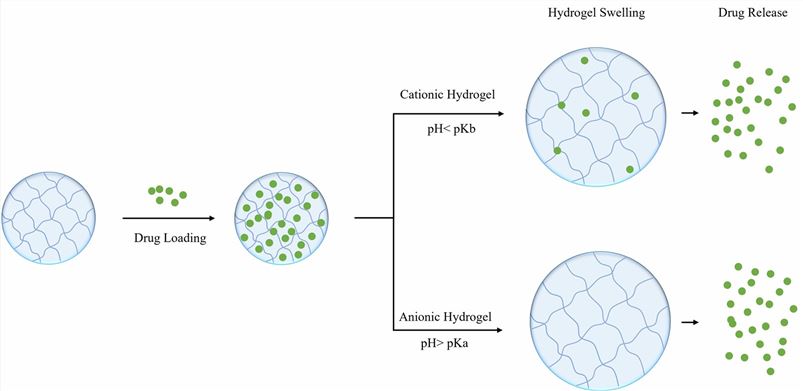pH-Sensitive Peptide & Protein Hydrogel Development
InquiryCD Formulation offers comprehensive development services for pH-sensitive hydrogels aimed at optimizing the delivery of peptide and protein therapeutics. Our team of formulation scientists, chemical engineers and biologists work closely with clients to design hydrogels customized for specific molecules and disease targets.
What is pH-Sensitive Hydrogel?
The swelling behavior and permeability of pH-sensitive hydrogels are dependent on the pH level of the environment. The polymer chains of pH sensitive hydrogels contain ionizable functional groups such as carboxylic acids or amines whose ionization state and charge density change in response to pH shifts. This allows pH sensitive hydrogels to swell and contract reversibly at different pH values, making them suitable for controlled drug delivery applications triggered by pH changes in tissues.
How Do We Develop pH-Sensitive Peptide & Protein Hydrogels?

| Hydrogel Formulation |
- Select polymer(s) and crosslinker(s) based on desired pH responsiveness and biocompatibility.
- Adjust polymer concentration, crosslinking density, and ratio to optimize gel properties.
|
| Encapsulation of Peptides/Proteins |
- Prepare a solution of peptides/proteins in an appropriate buffer.
- Mix the solution with the hydrogel precursor, ensuring uniform distribution.
- Centrifuge or filter to remove any aggregates or contaminants.
|
| Characterization and Optimization |
- Analyze the hydrogel's mechanical properties, such as gelation kinetics and swelling behavior, using a rheometer.
- Assess the encapsulation efficiency and release kinetics of peptides/proteins using UV-vis spectrophotometry or other suitable methods.
- Optimize formulation based on desired release profiles.
|
Our Materials for pH-Sensitive Hydrogel Development
| Types |
Natural Materials |
Synthetic Materials |
| Examples |
- Chitosan
- Guar gum
- Carrageenan
- Dextran
- Xanthan
- Cellulose
- Alginate
|
- Poly (acrylic acid)
- Poly (acrylamide)
- Poly (vinyl alcohol)
- Poly (ethylene glycol)
- Poly (vinyl pyrrolidone)
- Poly (lactic acid)
|
| Advantages |
- Nontoxic
- Low cost
- Rich sources
- Biocompatibility
- Biodegradable
|
- Customizability
- Good mechanical strength
- Precise control of drug release kinetics
- Suitable for commercial production
- Biocompatibility
|
| Disadvantages |
- Poor mechanical properties
- Batch variability
|
- Potential immunogenicity
- Degradation of products
- Costly for complex formulations
|
Applications of Our pH-Sensitive Peptide & Protein Hydrogels
pH-sensitive hydrogels have great potential for oral delivery of peptides/proteins. At CD Formulation, these hydrogels can be formulated to remain stable in the acidic environment of the stomach and swell or dissolve in the alkaline conditions of the intestine. This pH-triggered behavior enables controlled release of drugs at specific sites in the gastrointestinal tract.
CD Formulation can help customers develop pH-sensitive hydrogels for injection. These hydrogels can be designed to undergo a gelation or sol-gel transition in response to the physiological pH of the target tissue or site. After injection, the hydrogel forms a reservoir or scaffold that slowly releases the encapsulated drug, providing sustained and localized drug delivery.
- Transdermal Administration
The skin's stratum corneum possesses a pH gradient critical to its barrier function. At CD Formulation, we design smart pH-sensitive hydrogels optimized for cutaneous administration. Our hydrogels are tuned to react to the skin's natural pH levels, governing drug release kinetics. These innovative systems hold potential for acne treatment, combating bacterial infections, and solving various dermatological issues.
Highlights of Our pH-Sensitive Hydrogel Development Services
- pH-sensitive hydrogels provide a stable environment for the encapsulation and delivery of peptides and proteins.
- Our pH-sensitive hydrogels enable precise control over the release kinetics of peptides and proteins.
- pH-sensitive hydrogels can undergo controlled swelling, gelation, or sol-gel transition in response to pH changes, facilitating on-demand release and localization of peptides and proteins at the desired site.
- Our pH-sensitive hydrogels are designed to be biocompatible.
By adjusting hydrogel composition and cross-linking parameters, CD Formulation can design systems that release encapsulated biomolecules in a controlled and sustained manner, providing tailored solutions for peptide and protein delivery. If you have a peptide or protein that could benefit from our pH-responsive delivery technology, please contact us! We will utilize our innovative hydrogel design capabilities and deep application knowledge to formulate customized solutions for your unique development needs and research goals.
Reference
- Zhang J.; et al. Fabrication and evaluation of a novel polymeric hydrogel of carboxymethyl chitosan-g-polyacrylic acid (CMC-g-PAA) for oral insulin delivery. RSC Adv. 2016, 6:52858–52867.
Related Services


